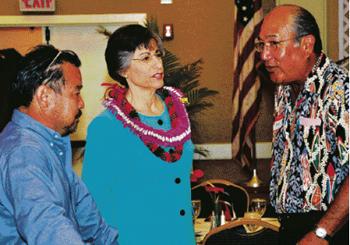NUKOLI‘I — Gov. Linda Lingle wants the Kaua‘i Island Utility Cooperative to be part of the state’s effort in attaining 70 percent clean energy by the year 2030. She voiced that desire during her keynote address at the Kapa‘a Business
NUKOLI‘I — Gov. Linda Lingle wants the Kaua‘i Island Utility Cooperative to be part of the state’s effort in attaining 70 percent clean energy by the year 2030.
She voiced that desire during her keynote address at the Kapa‘a Business Association General Membership Meeting, Wednesday at the Hilton Kaua‘i Beach Resort.
Prior to her remarks, Lingle presided over the installation of the KBA’s new officers and directors which include: Steve Thatcher, president; Bob Bartolo, vice president; Melissa Costales, secretary; Chris Dorland, treasurer; and directors Joe Adorno, Andy Friend, Michael Hough, Kenny Ishii, Rich Jasper, Neill Sams and Christobel Kealoha.
“This is not business as usual,” Lingle said about the current economic uncertainty. “Hawai‘i is the most oil-dependent state in the nation, so the transition (to alternative energy sources) is important.”
The working agreement between the state and Hawaiian Electric did not come easy, Lingle said, but she would like to see some kind of partnership with KIUC.
She is encouraged by the many places on Kaua‘i making the switch to alternative energy, the most recent being the new photovoltaic systems at Pioneer Hi-Bred and Wilcox Memorial Hospital.
“You can come up with the greatest ideas, but when you flick the switch and the light doesn’t go on, you go see the utility company,” Lingle said. “Reliability is the highest priority, but not above energy security if there is no oil.”
Lingle pointed out advances in the state’s move to reduce its dependency on fossil fuels for energy production, pointing out that the agreement with HECO states there will be no more fossil fuel plants being built. Instead, they are looking at big wind plants.
She also noted a legislative change with Act 31 which allows the construction of solar farms on agricultural land that is not especially suited for growing food.
Lana‘i took advantage of this amendment to build a solar farm which produces 30 percent of the island’s power needs, Lingle said.
“We have to get past looking for the perfect solution because there is no perfect solution,” Lingle said.
On a trip to China, Lingle said she was told by a Chinese man that energy sources from wind, solar or waves are all energy from heaven.
In other areas, Lingle reiterated her economic stimulus plans that include increased efforts in tourism marketing, improved infrastructure and the lowering of business taxes and fees.
“We need to deal with the immediate but plan for the long term,” Lingle said. “One of our greatest assets is the people and if the decisions we make harm the people, we haven’t really accomplished anything.”
Kaua‘i has a lot at stake in the $240 million “Recreational Renaissance” plan proposed last month by her administration, she said.
Kaua‘i, with $63.3 million worth of projects slated, would be the second highest county recipient next to O‘ahu.
“Kaua‘i people need to come out Friday when the Department of Land and Natural Resources hosts its meeting at the Chiefess Kamakahelei Middle School,” Lingle said. “We need to know what we missed, and this is an exciting opportunity for citizens in the community to get involved.”
Following the KBA event, Lingle shifted to another meeting with leaders of the visitor industry to discuss the state’s efforts on the increased marketing of the state.


